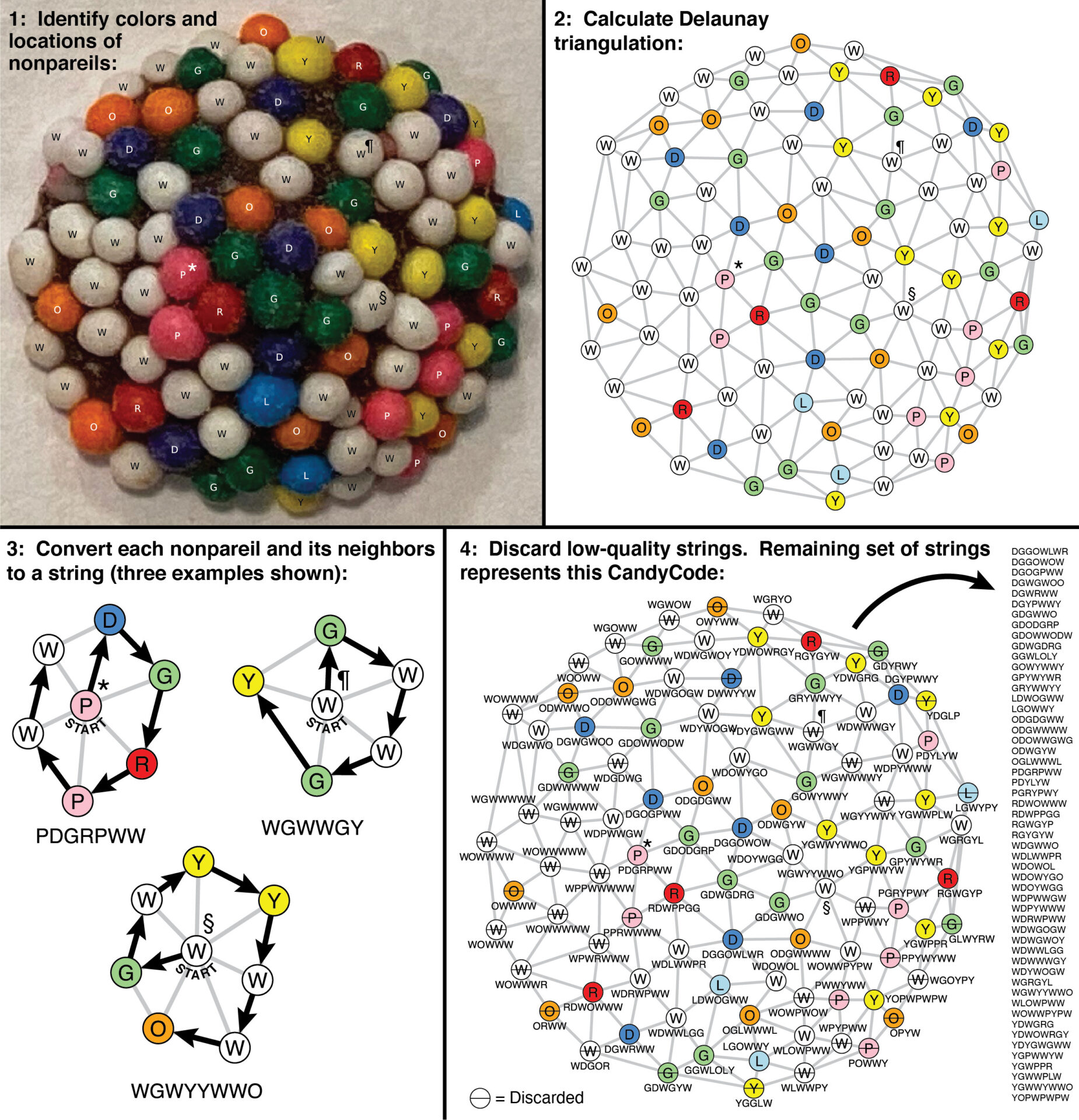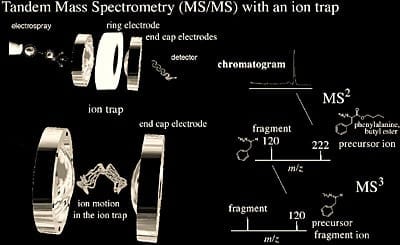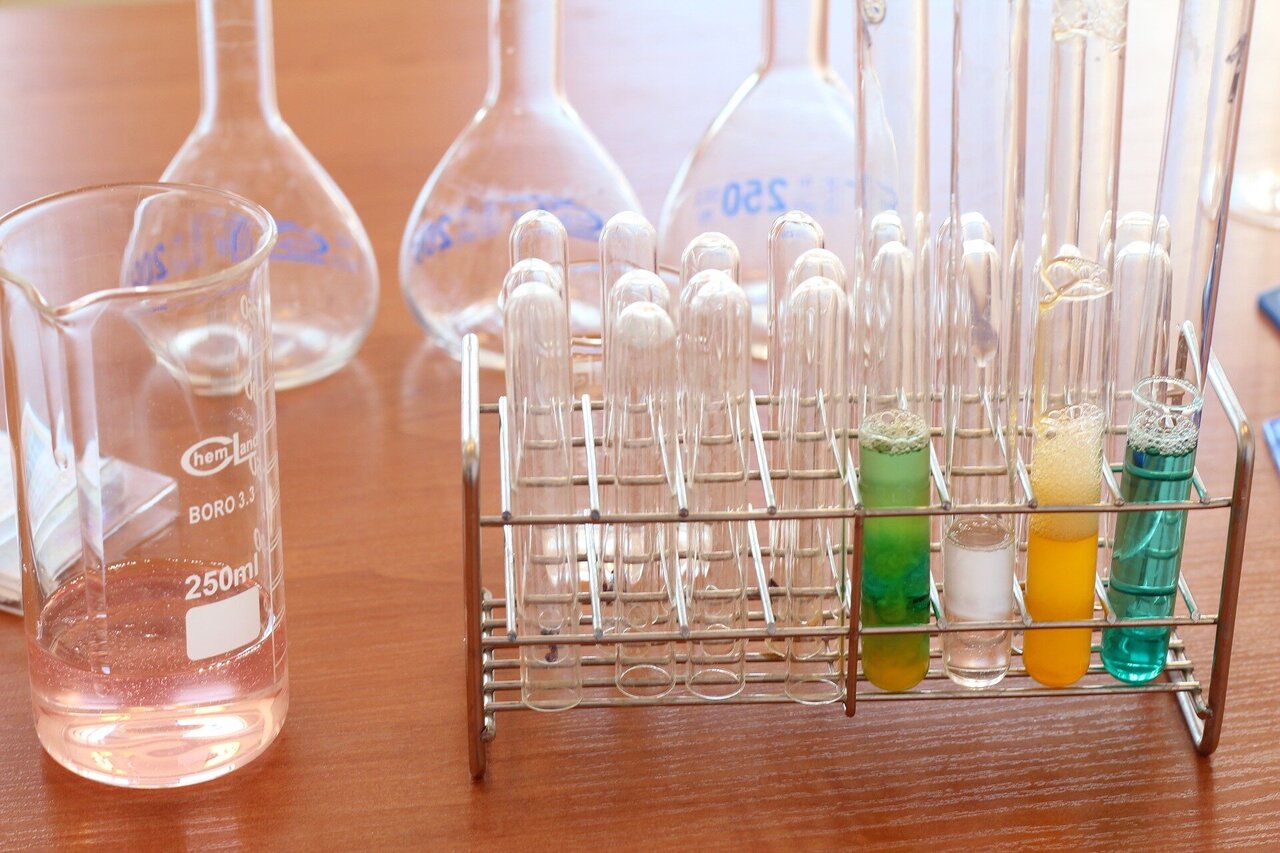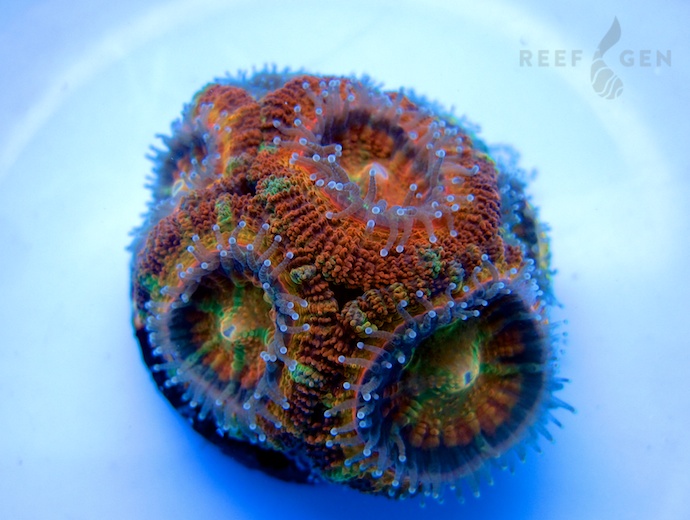
Diagram showing how a photograph of candy nonpareils are converted into a string of code suitable for storage in a database.
(Grover, 2022)
While most of us were baking sourdough bread and watching “Tiger King” to stay sane during the pandemic shutdown, UC Riverside bioengineering professor William Grover kept busy counting the colorful candy sprinkles perched on top of chocolate drops. In the process, he discovered a simple way to prevent pharmaceutical fraud.
The technique, which he calls CandyCode and uses tiny multicolored candy nonpareils or “hundreds and thousands” as a uniquely identifiable coating for pharmaceutical capsules and pills, is published in Scientific Reports.
Counterfeit or substandard medicines harm millions of people and cost an estimated $200 billion annually. In the developing world, the World Health Organization estimates that one in 10 medical products is fake.
Grover’s lab has previously worked on simple, low-cost ways to ensure the authenticity of pharmaceuticals. Other researchers have been interested in putting unique codes on pills that can be used to verify their authenticity, but all of those schemes have practical limitations.
“The inspiration for this came from the little colorful chocolate candies. Each candy has an average of 92 nonpareils attached randomly, and the nonpareils have eight different colors. I started wondering how many different patterns of colored nonpareils were possible on these candies,” said Grover. “It turns out that the odds of a randomly generated candy pattern ever repeating itself are basically zero, so each of these candies is unique and will never be duplicated by chance.”
This gave Grover the idea that the nonpareils could be applied as a coating to each pill, giving it a unique pattern that could be stored by the manufacturer in a database. Consumers could upload a smartphone photograph of a pill and if its CandyCode matches one in the database, the consumer could be confident that the pill is genuine. If not, it is potentially fraudulent.
To test this idea, Grover used edible cake decorating glue to coat Tylenol capsules with nonpareils and developed an algorithm that converts a photo of a CandyCoded pill into a set of text strings suitable for storing in a computer database and querying by consumers. He used this algorithm to analyze a set of CandyCode photos and found they function as universally unique identifiers, even after subjecting the CandyCoded pills to physical abuse that simulates the wear-and-tear of shipping.
“Using a computer simulation of even larger CandyCode libraries, I found that a company could produce 10^17 CandyCoded pills—enough for 41 million pills for each person on earth—and still be able to uniquely identify each CandyCoded pill,” Grover said.
Even more unique CandyCodes could be created with the introduction of more colors or combining different sizes or shapes of candy nonpareils. CandyCodes could also be used to ensure the authenticity of other products that are often counterfeited. Bottle caps, for example, could be coated with adhesive and dipped in nonpareils to ensure the integrity of perfume or wine and garment or handbag hang tags could be coated with glitter.
CandyCoded capsules or tablets have an unexpected benefit for the consumer as well.
“Anecdotally, I found that CandyCoded caplets were more pleasant to swallow than plain caplets, confirming Mary Poppins’ classic observation about the relationship between sugar and medicine,” said Grover.
The open access paper, “CandyCodes: simple universally unique edible identifiers for confirming the authenticity of pharmaceuticals,” is available here.
Original Article: Candy-coated pills could prevent pharmaceutical fraud
More from: University of California Riverside
The Latest Updates from Bing News & Google News
Go deeper with Bing News on:
Pharmaceutical fraud
- RPHM Stock Alert: Halper Sadeh LLC Is Investigating Whether the Merger of Reneo Pharmaceuticals, Inc. Is Fair to Shareholders
Halper Sadeh LLC, an investor rights law firm, is investigating whether the merger of Reneo Pharmaceuticals, Inc. (NASDAQ: RPHM) and OnKure, Inc. is fair to Reneo shareholders. Pre-merger Reneo ...
- Fraud Allegations: Case Filed Against Pharmaceutical Agencies in Thane for Distributing Counterfeit Medicines
Two pharmaceutical agencies face charges for distributing counterfeit medications to Thane hospitals. FDA inspections uncovered the deception, leading to an FIR under various Indian laws. The agencies ...
- Healthcare Fraud: A World Beyond the Anti-Kickback Statute
DOJ’s Recent Application of Honest Services Fraud Just this year, in a case from the Northern District of Texas, DOJ indicted ten doctors, two pharmaceutical reps, and two separate business entities ...
- Pharmaceutical industry in South Korea - statistics & facts
The pharmaceutical industry in South Korea is a significant industry, worth around 29.9 trillion South Korean won as of 2022. That same year, pharmaceutical spending accounted for approximately 1. ...
- SHAREHOLDER ALERT: Pomerantz Law Firm Investigates Claims On Behalf of Investors of Reviva Pharmaceuticals Holdings, Inc. - RVPH
NEW YORK, NY / ACCESSWIRE / May 4, 2024 / Pomerantz LLP is investigating claims on behalf of investors of Reviva Pharmaceuticals Holdings, Inc. ("Reviva" or the "Company") (NASDAQ:RVPH). Such ...
Go deeper with Google Headlines on:
Pharmaceutical fraud
[google_news title=”” keyword=”pharmaceutical fraud” num_posts=”5″ blurb_length=”0″ show_thumb=”left”]
Go deeper with Bing News on:
CandyCodes
- Walmart Promo Codes
Walmart is one of the largest retailers in the world and continues to be a trusted destination for shoppers looking for low prices. The brand is not indifferent to innovation and environmental ...
- Rock Fruit Codes (May 2024)
Open Rock Fruit in Roblox. Click on the Codes button. Enter your code into the textbox. Click on the Redeem button. Enjoy your free rewards! Why Aren’t My Codes Working in Rock Fruit? There are ...
- Roblox Dress To Impress Codes (April 2024)
Dress To Impress is a popular Roblox game where you can live out your dream as a model. Before you enter your first competition, you can give yourself a headstart by redeeming these codes to get ...
- Tower Defense Simulator codes for May 2024
13th May 2024: We added new TDS codes. Tower Defense Simulator is the Roblox game that pairs you up with other players so that you can work together to defeat wave after wave of Zombies!
- Dead by Daylight codes for May 2024
13th May 2024: We added new DBD codes. Behaviour Interactive issues Dead by Daylight codes on a fairly regular basis, and that’s a good thing. Dead by Daylight codes usually give you free ...
Go deeper with Google Headlines on:
CandyCodes
[google_news title=”” keyword=”CandyCodes” num_posts=”5″ blurb_length=”0″ show_thumb=”left”]











